A Brief Guide to the Wild Birds of the Museum
When I was little, I wanted to become a veterinarian because I wanted to help animals, and I thought treating sick or injured pets would be the best way to get tangible results. This logic applied more to cats and dogs, since I grew up with them. Despite growing up with this avid interest in animals and being raised in a family that would always spend time outside, I hadn’t noticed how little I knew about birds, because I saw them every day and never thought twice about it. I thought birds were beautiful and was more interested in drawing them or just observing them in the wild rather than memorizing species names and facts like many avid birders do. It wasn’t until I became aware of the multitude of birds present that I may not see in the city, and how helping animals really comes down to protecting the environment as a whole, that I began exploring what bird species are in my area and what ecological services they provide.
Birds are everywhere: nesting in the eaves of our houses, gliding through parks, perching in the trees stretched above us. They are a vital part of our ecosystems, and knowing more about them will equip you with knowledge to be a better steward of the environment or even provide you with a new pastime in the form of birdwatching. One place you can start with is the Museum, as it is an amazing place to observe birds with its calm ambiance and relaxing setting surrounded by nature. I created the following guide to introduce budding birders to some bird species that can be found on the Museum campus, some of which are also commonly seen throughout the Santa Barbara area.
This guide is organized by size, starting with the smallest and ending with the largest, to make it easy to find birds of interest. Besides providing information on what each bird looks like, this guide places an emphasis on each species’ ecological role by discussing what they eat and how their populations have been affected by anthropogenic (human-caused) and natural disturbances. Diet in particular is important because it shows how one animal affects a multitude of others by balancing food chains—controlling some populations and providing food for others. Additionally, knowing the threats to these birds may open your eyes to some changes you can make in your daily life to protect birds, and how much they are affected by factors many people aren’t aware of. You’ll find–as I have–that you don’t need to be a veterinarian to help animals, and the birds you pass by every day have a larger effect on their surroundings than you’d expect.
Very Small Birds: about 3.0–5.0 inches in length
Photo by Brent Flaaten
Anna’s Hummingbird, Calypte anna (~3.0 to 3.9 inches)
Family: Hummingbirds (Trochilidae)
Seasons Found: Common during all seasons
Conservation Status: Low Concern
Distinctive Features: emerald and gray feathers; males have rose colored throats and heads; sharp and rapid chirps
Anna’s Hummingbirds eat nectar from a variety of flowers, which include manzanita, eucalyptus, gooseberry, and currant. They’ll also eat sap that’s available from holes made by sapsuckers. In order to catch insects, Anna’s Hummingbirds will fly out and catch them in midair, hover and pluck them from plants, and find them in streambanks or caught in spiderwebs and other crevices. They usually eat smaller insects such as midges, whiteflies, and leafhoppers. Some threats to Anna’s Hummingbird populations are urbanization and wildfires which destroy natural habitats, and spring heat waves which are related to climate change.
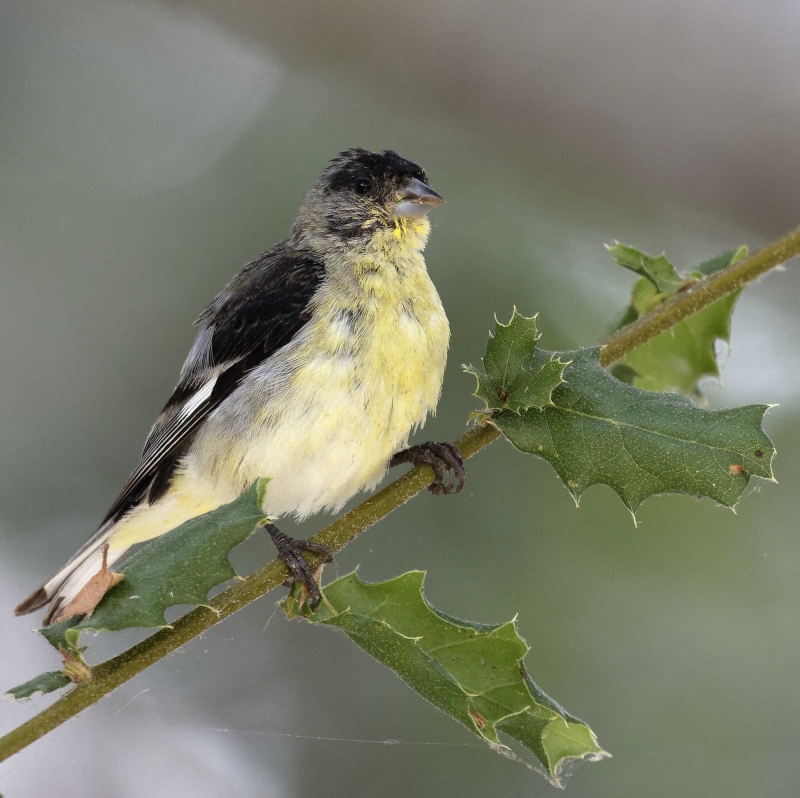
Photo by Daniel Geiger
Lesser Goldfinch, Spinus psaltria (~3.5 to 4.7 inches)
Family: Finches, Euphonias, and Allies (Fringillidae)
Seasons Found: Common during all seasons
Conservation Status: Low Concern
Distinctive Features: Bright yellow, grayish olive, and black coloring; white patches on the wings; song consists of trills, twittering, and stutters
Lesser Goldfinches mainly eat seeds, with a preference for plants in the daisy and sunflower family, for example the thin-hulled seeds of Nyjer Thistles. They will also eat the flowers and buds from trees such as cottonwood, and some berries like the coffeeberry and elderberry. According to Cornell Lab of Ornithology’s All About Birds, Lesser Goldfinches will occasionally eat insects such as aphids and plant lice to supplement their diets. When eating seeds, they will use their bills to peel the outer covering of seeds, shake their head to loosen the covering, and swallow the seed. For tall plants, Lesser Goldfinches will bend the plants and hang upside down by clinging onto the seeds to pick at them. One thing that has been found to attract Lesser Goldfinches and possibly boost their populations is the increase of street trees, which provide more habitats for birds, especially native species.
Photo by Brent Flaaten
Orange-crowned Warbler, Leiothlypis celata (~4.8–5.2 inches)
Family: Wood-Warblers (Parulidae)
Seasons Found: Common during all seasons
Conservation Status: Low Concern
Distinctive Features: Slim, unpatterned, variably grayish-green-yellow; simple trill
Orange-crowned Warblers will eat insects such as flies and beetles, as well as spiders and caterpillars. They find insects by skimming through shrubs, trees, and other vegetation. Their small, sharp bills poke around bark, moss, and leaf litter for hidden prey. Warblers will also eat fruit, berries, and tree sap made accessible by woodpeckers. Orange-crowned Warblers share the same predators of other small, perching songbirds: snakes, larger birds of prey, foxes, house cats, and weasels.

Photo by Gary Robinson
Yellow-rumped Warbler, Setophaga coronata (~4.7–5.5 inches)
Family: Wood-Warblers (Parulidae)
Seasons Found: Winter and during spring/fall migration
Conservation Status: Low Concern
Distinctive Features: highly variable winter plumage where yellow on the sides, throat, and crown may not be visible; brighter breeding colors during spring migration; bright yellow rump visible during all seasons; sharp chirps and warbles
Yellow-rumped Warblers are omnivores who will eat both insects and berries. Their diets also include caterpillars, wasps, grasshoppers, beetles, spiders, and a serious forest pest called spruce budworm. They catch insects by hovering above foliage as well as searching among twigs and leaves. Unlike many other birds, Yellow-rumped Warblers can digest the wax in berry coatings and will eat berries such as juniper, Poison Ivy, Wax Myrtle, and grapes. They’ll also eat wild seeds from plants such as beach grasses and goldenrod. Like many other migratory birds, Yellow-rumped Warblers are susceptible to being killed in building collisions such as with radio towers and windows.
Small Birds: about 5.0–9.0 inches in length
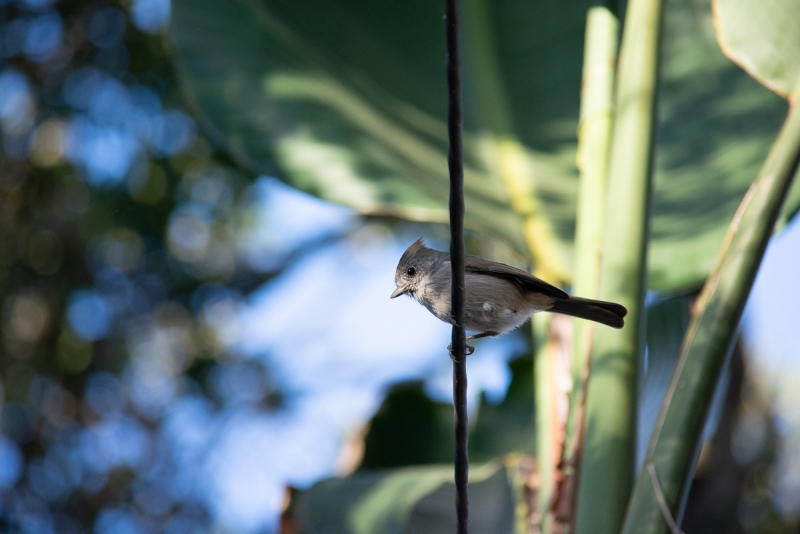
Oak Titmouse, Baeolophus inornatus (~5.0–5.5 inches)
Family: Tits, Chickadees, and Titmice (Paridae)
Seasons Found: Common during all seasons
Conservation Status: Declining, At risk of becoming endangered
Distinctive Features: gray-brown; peaked crown; slightly darker on top; vocal, with harsh and rapid calls
The Oak Titmouse will eat insects, nuts, and seeds, as well as caterpillars, beetles, and spiders. Additionally, they eat acorns, and sometimes berries and small fruits such as cherries. The decline in Oak Titmouse populations is due to the rise in California’s human population. Rising human populations have led to increased timber harvesting, clearing for agriculture, and urban and suburban development, which creates pressure on oak woodlands. According to Cornell’s All About Birds, landowners could play an extremely significant role in preserving Oak Titmouse habitats, because around 80% of California's remaining oak woodlands are privately owned.

Photo by Daniel Geiger
White-breasted Nuthatch, Sitta carolinensis (~5.1–5.9 inches)
Family: Nuthatches (Sittidae)
Seasons Found: Common during all seasons
Conservation Status: Low Concern
Distinctive Features: gray upperparts; black or gray crown; white face and underbelly; long, slightly upturned bill; often move down tree trunks headfirst; loud, nasal, and persistent call
White-breasted Nuthatches primarily eat seeds, nuts, and acorns, as well as some insects and spiders. In order to get the seeds inside of acorns, they will jam them into the bark of trees and hit them with their sharp bills, hence the name “nuthatch.” If you notice a nuthatch continuously taking seeds from your feeder and coming back, it’s probably storing them by wedging them in the bark of trees nearby for later in winter. White-breasted Nuthatches need dead trees to nest in holes, so excessively pruning trees and getting rid of dead material can decrease nesting chances.

Photo by Daniel Geiger
House Finch, Haemorhous mexicanus (~5.0–6.0 inches)
Family: Finches, Euphonias, and Allies (Fringillidae)
Seasons Found: Common during all seasons
Conservation Status: Low Concern
Distinctive Features: brown and buff streaky tones with white markings (“dots” that form sort of stripes); males have orange-red on head, breast, and at base of tail
The diet of House Finches is made up of seeds, buds, and berries. In the spring, they will also eat parts of flowers, and in the late summer they’ll be found eating small fruits. As adults, they will eat insects, but only a few small ones like aphids. House Finches only feed their nestlings “plant foods” (regurgitated seeds), which is rare for birds–even those that are vegetarian as adults. The red coloring that male House Finches have is due to the pigment in their food; the more pigment in their food, the brighter the red in the male. So, it is also common to see orange or yellow males, although females tend to prefer to mate with the redder ones because they want a male who can contribute to feeding nestlings well. According to the Cornell Lab of Ornithology, local populations of House Finch in some areas have been especially affected by conjunctivitis, which is a bacterial infection that makes their eyes swell shut and prevents them from being able to adequately feed themselves. To prevent the spread of conjunctivitis in House Finches, people can regularly clean their bird baths and feeders, clear the area around feeders, avoid using moldy seeds, and ensure that feeders aren’t overcrowded.
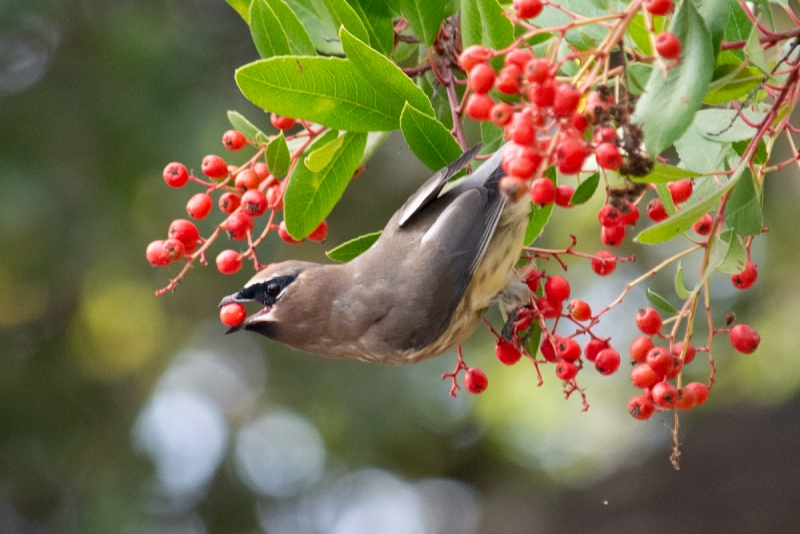
Cedar Waxwing, Bombycilla cedrorum (~6.0–7.0 inches)
Family: Waxwings (Bombycillidae)
Seasons Found: Winter
Conservation Status: Low Concern
Distinctive Features: brown, gray, peachy-tan, and yellow; black mask; tail has a tip of bright yellow; wings have red waxy tips; seen in large flocks in winter; high and rapid trills
As one of the few North American birds that can survive on fruit for months, Cedar Waxwings specialize in eating fruit. They eat fruits year-round, some of which include mistletoe, juniper, honeysuckle, and russian olive fruits. They also eat scale insects, leaf beetles, caterpillars, ants, some flowers, and will drink oozing sap. In the winter, when you would see them in our area, Cedar Waxwings more commonly eat Toyon, mistletoe, and other berries supplemented with protein rich insects such as mayflies and dragonflies. Due to their diet mainly consisting of fruit, occasionally they can become intoxicated or even die from consuming too many overripe berries that have fermented and produce alcohol. Cedar Waxwing populations can be bolstered by promoting the growth of native plants and reducing the threat of getting hit by cars, as they are often found on roadsides feeding on fruit trees.
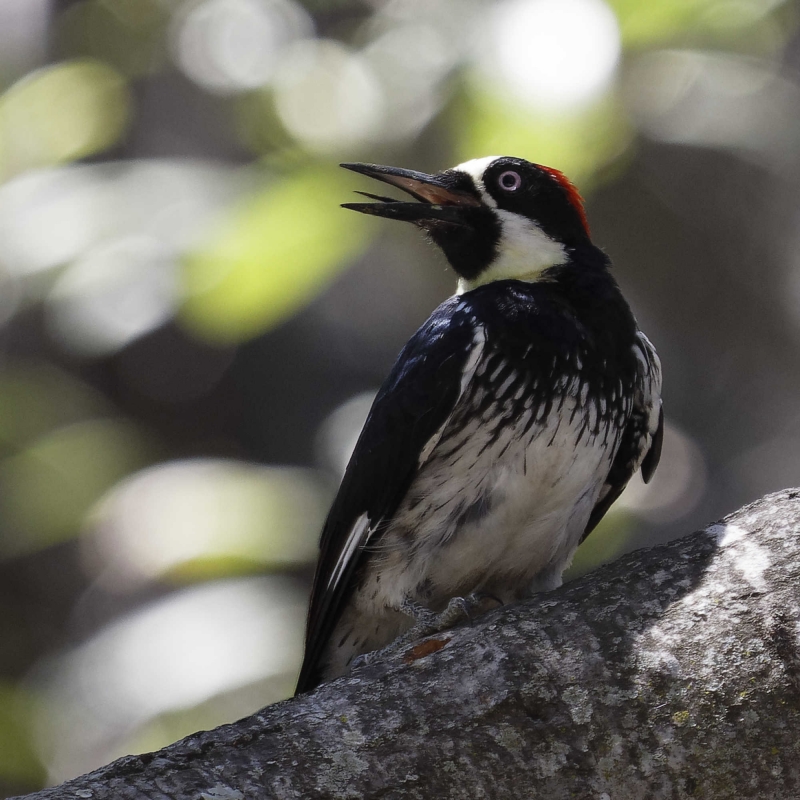
Photo by Daniel Geiger
Acorn Woodpecker, Melanerpes formicivorus (~7.5–9.1 inches)
Family: Woodpeckers (Picidae)
Seasons Found: Common during all seasons
Conservation Status: Low Concern
Distinctive Features: black with white underbelly; white iris and face (often referred to as “clown-faced”); red cap; display three white patches when in flight; squeaky waka waka and trills
About half of the Acorn’s Woodpecker’s diet consists of acorns that they hoard in granary trees. Those granary trees can be used for generations. They will also eat various nuts, seeds, fruits, and insects–especially ants. Sometimes, they will even eat the eggs of other birds. Acorn Woodpeckers are also found feeding on tree sap by digging holes into the bark or using holes that were previously made by sapsuckers. The main threat to Acorn Woodpeckers is their reliance on specific oak habitats, which may become more vulnerable to climate change. With increased wildfires, habitats are burning too frequently to recover. Climate change also brings spring heat waves that may endanger young birds in their nests.
Medium Birds: about 9.0–16.0 inches in length

Photo by Daniel Geiger
California Towhee, Melozone crissalis (~7.9–9.8 inches)
Family: Sparrow (Passerellidae)
Seasons Found: Common during all seasons
Conservation Status: Low Concern
Distinctive Features: chunky, gray-brown sparrow-type birds with cinnamon accents on undertail and face; loud and sharp chirp
California Towhees live mostly on or near the ground, so their diets mainly consist of seeds and insects such as caterpillars, grasshoppers, and beetles. They also eat spiders, snails, berries, and garden fruits. Predators of California Towhees are mostly mammals such as opossums, raccoons, and house cats. Some threats to California Towhee populations are fires and heat waves, which are both climate-related. Like with many bird species, urbanization also poses a threat to California Towhees, as land that serves as bird habitat is developed.

Photo by Gary Robinson
American Robin, Turdus migratorius (~7.9–11.0 inches)
Family: Thrushes and Allies (Turdidae)
Seasons Found: Common during all seasons
Conservation Status: Low Concern
Distinctive Features: gray-brown with orange underparts; dark heads with white broken eye ring; cheery, caroling call
American Robins eat a wide variety of foods including insects, berries, earthworms, snails, spiders, and invertebrates. In the winter they eat a lot of fruits, usually wild berries. These birds are present where a lot of people live and they act as an early indicator of environmental problems, such as the overuse of pesticides and chemical pollution. Since robins often forage on lawns, a decreased presence of robins may indicate the absence of invertebrates and therefore point to the excessive use of pesticides.
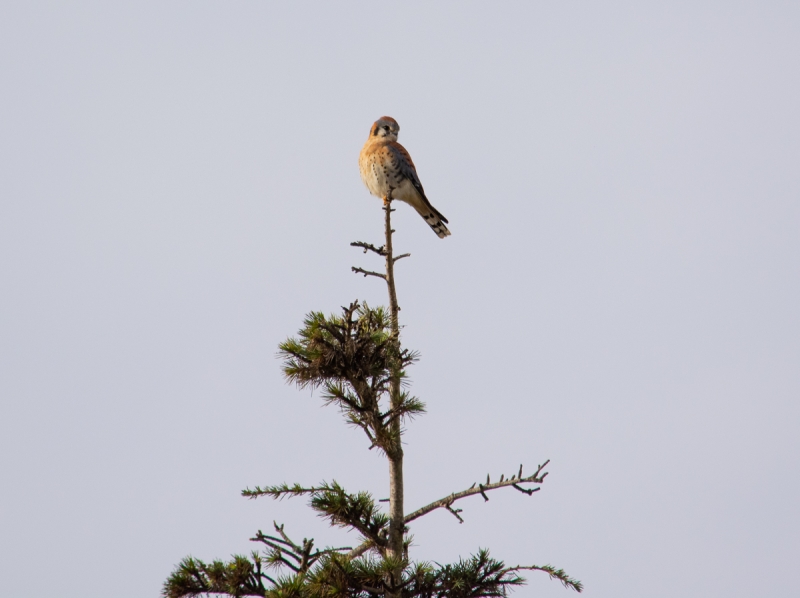
American Kestrel, Falco sparverius (~8.0–11.0 inches)
Family: Falcons and Caracaras (Falconidae)
Seasons Found: Common during all seasons
Conservation Status: Low Concern
Distinctive Features: rusty brown with black spots; females have brown-red on wings, back, and tail; males have gray-blue heads and wings; call consists of loud, shrill, “killy” notes
American Kestrels eat small rodents and birds, as well as insects and other invertebrates. This range includes grasshoppers, beetles, cicadas, scorpions, spiders, butterflies, moths, voles, mice, shrews, bats, and small songbirds. They will also sometimes eat lizards, small snakes, frogs, and earthworms. American Kestrels will hide their kills in grass clumps, bushes, fence posts, tree limbs, and roots to save surplus for when they are low or to hide them from thieves. The main threats to American Kestrel populations are poison, pesticides, and other pollutants because they can reduce hatching success, kill their prey, and lead to the indirect consumption of poison. American Kestrels are also threatened by habitat loss as the open country, brush, and dead trees that they rely on for providing prey and nesting spots are becoming scarce due to development and unsustainable farming practices.
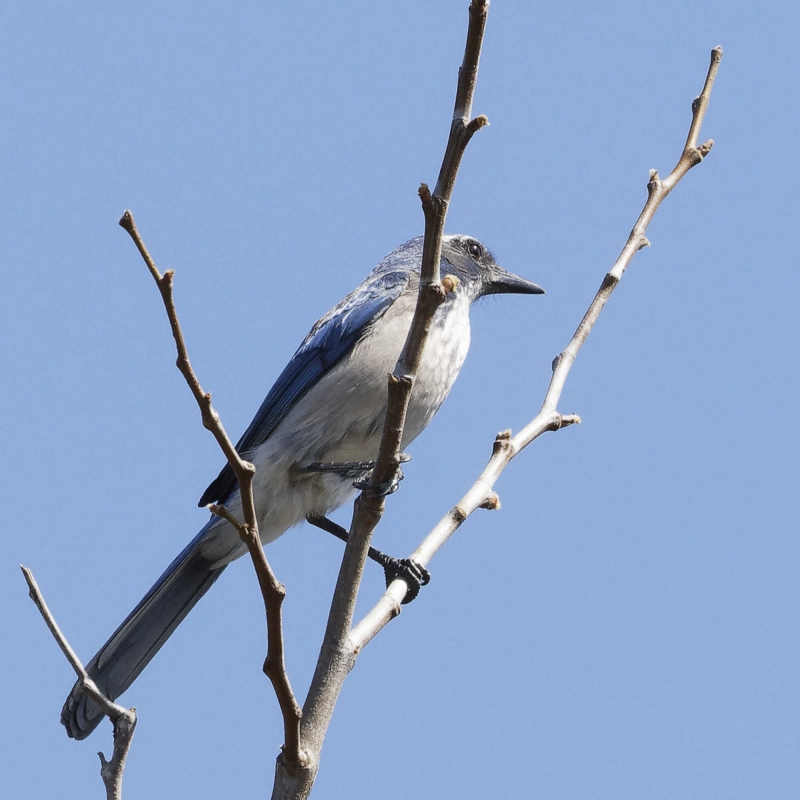
Photo by Daniel Geiger
California Scrub-Jay, Aphelocoma californica (~11.0–12.0 inches)
Family: Crows, Jays, and Magpies (Corvidae)
Seasons Found: Common during all seasons
Conservation Status: Low Concern
Distinctive Features: greyish brown; deep blue on top of the head, wings, and tails; white underparts; move in big hops and lunges with sharp turns of the head; According to the Cornell Lab of Ornithology, they will often “clack their bill mandibles together to make a sharp rapping”
During the spring and summer, California Scrub-Jays tend to eat mainly insects and fruit, and nuts and seeds during the fall and winter. They will also eat small animals such as lizards, spiders, snails, and rodents. California Scrub-Jays sometimes follow adult birds in order to locate their nests to eat their eggs and nestlings. Acorns and grass seeds, sunflower seeds and peanuts in feeders, corn, almonds, walnuts, and cherries are also a part of their diet. To get meat from an acorn, California Scrub-Jays will hold it between their feet and hammer it with their bill.

Mourning Dove, Zenaida macroura (~9.1–13.4 inches)
Family: Pigeons and Doves (Columbidae)
Seasons Found: Common during all seasons
Conservation Status: Low Concern
Distinctive Features: brown and tan; white and black tipped, long pointed tails; black spots on wings; gentle, drawn-out “mournful” cooing (hence its name)
The diet of a Mourning Dove is made up almost entirely of seeds, some of which are from cultivated grains, grasses, and ragweeds. They swallow the seeds and store them in an enlarged part of their esophagus called the crop. Mourning Doves also occasionally eat snails and only very rarely do they eat insects. Interestingly, they can drink brackish spring water half the salinity of seawater, which allows them to survive even in desert areas. Mourning Doves spend a lot of time on the ground, so they may be particularly vulnerable to getting hunted by domesticated outdoor cats.
Large Birds: about 16.0–26.0 inches in length

Photo by Gary Robinson
Cooper’s Hawk, Accipiter cooperii (~14.0–20.0 inches)
Family: Hawks, Eagles, and Kites (Accipitridae)
Seasons Found: Found during all seasons
Conservation Status: Low Concern
Distinctive Features: slaty-gray backs; reddish horizontal barring on the breast and belly; strongly barred tail; dark cap on the head; white belly with tan markings; harsh, grating, cak-cak call
Cooper’s Hawks are carnivores whose diets consist of birds and small mammals. Their primary food includes medium-sized birds such as European Starlings, Mourning Doves, Rock Pigeons, American Robins, and jays, as well as nestlings. Only occasionally will Cooper’s Hawks eat smaller birds that are the size of quails, pheasants, and chickens. Additionally, they eat chipmunks, hares, mice, bats, and squirrels. When available, they can be found eating reptiles and amphibians. Cooper’s Hawks are affected in a similar manner to American Kestrels by urbanization and rat poison.
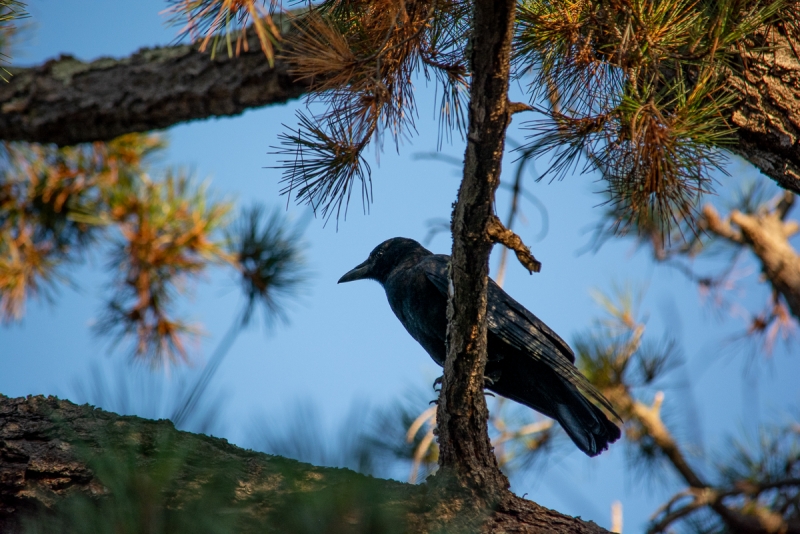
American Crow, Corvus brachyrhynchos (~15.8–20.9 inches)
Family: Crows, Jays, and Magpies (Corvidae)
Seasons Found: Common during all seasons
Conservation Status: Low Concern
Distinctive Features: large, all black, intelligent and highly social; hoarse cawing
Crows are opportunistic feeders that will eat almost anything they can find including insects, snails, earthworms, frogs, snakes, and the eggs and young of other birds. They’ll also eat garbage, seeds, grains, fruit, and carrion. The main threat to their populations is the West Nile virus, which began spreading in North America after 1999. Although American Crows are very adaptable birds with a wide variety of habitats and diets they can survive with, those that contract West Nile virus typically die within a week.

Photo by Brent Flaaten
Red-shouldered Hawk, Buteo lineatus (~17.0–24.0 inches)
Family: Hawks, Eagles, and Kites (Accipitridae)
Seasons Found: Common during all seasons
Conservation Status: Low Concern
Distinctive Features: banded tail; orangish-brown underparts with white; black and white checkered wings; shrill, hoarse “Keer! Keer! Keer!” scream
The diet of Red-shouldered Hawks consists of small mammals, lizards, snakes, and amphibians. Those small mammals include voles and chipmunks, and they also eat toads, snakes, and crayfish. Red-shouldered Hawks have even been recorded preying on sparrows, starlings, and doves. In order to snatch their food, they will perch in the forest canopy and glide down as soon as they spot their prey. Like many other bird species, Red-shouldered Hawks are threatened by habitat loss and building collisions (flying into windows).
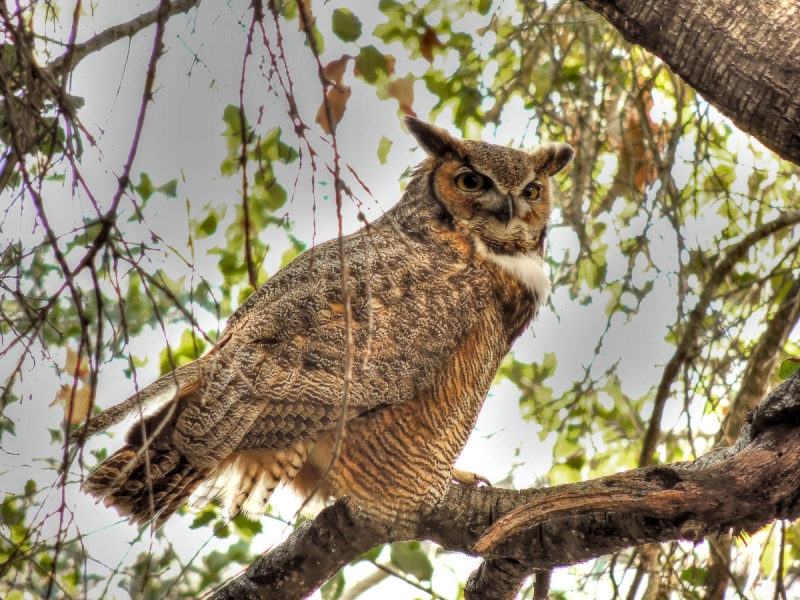
Photo by Gary Robinson
Great Horned Owl, Bubo virginianus (~18.0–25.0 inches)
Family: Owls (Strigidae)
Seasons Found: Common during all seasons
Conservation Status: Low Concern
Distinctive Features: feathery “ear” tufts; spotted gray-brown and sooty-colored overall; reddish brown on the face, white patch on throat; low series of hoots
Great Horned Owls eat mostly mammals and birds. This includes rats, mice, rabbits, ground squirrels, opossums, skunks, and mammals. They are known as one of the most dangerous predators to crows, and will also prey on birds up to the size of geese, ducks, hawks, and smaller owls. Along with mammals and birds, their diet includes snakes, lizards, frogs, insects, scorpions, and sometimes carrion. Great Horned Owls can be poisoned by pesticides and pollutants that accumulate in their prey, and were especially impacted in the past by hunting. Although it’s illegal to hunt Great Horned Owls now, illegal hunting still persists.

Photo by Brent Flaaten
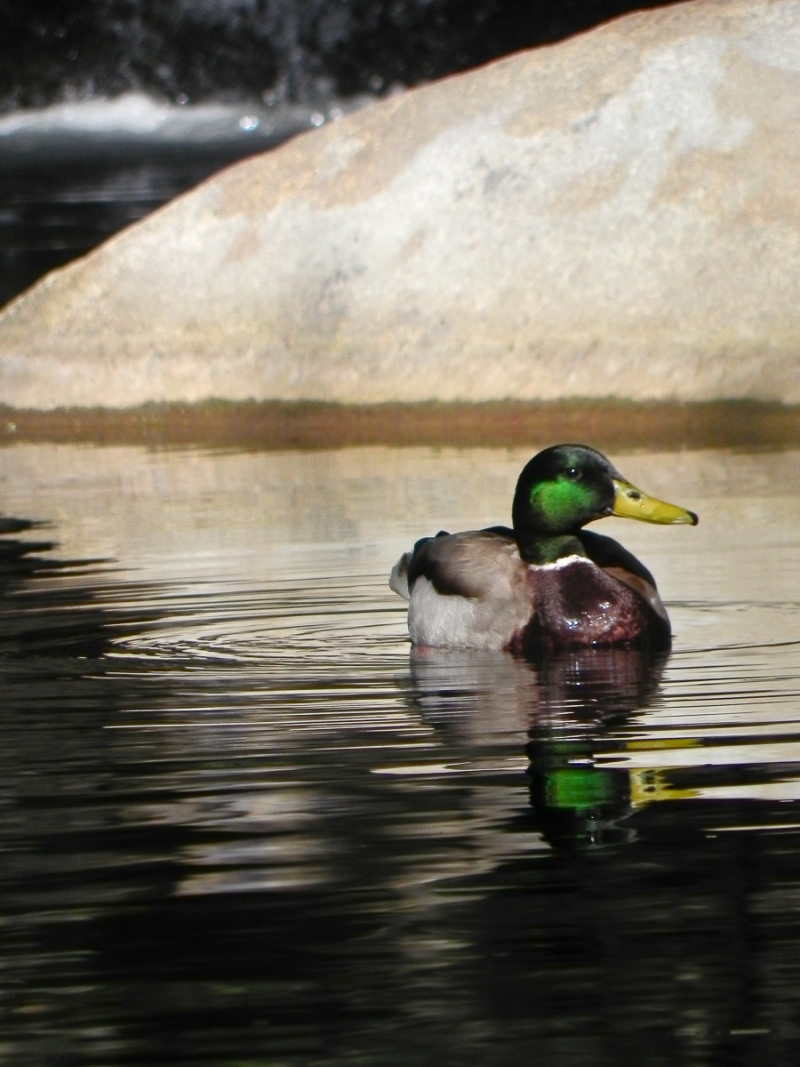
Photo by Gary Robinson
Mallard, Anas platyrhyncos (~20.0–26.0 inches)
Family: Ducks, Geese, and Waterfowl (Anatidae)
Seasons Found: Common during all seasons
Conservation Status: Low Concern
Distinctive Features: females are a mottled brown and tan with orange-brown bills; males have a green head with white band around the neck, a chestnut-colored chest, and gray body; females make loud quacks and males have raspy, softer calls
Mallard ducks are omnivores that eat seeds, plant material, and aquatic organisms. They eat aquatic insect larvae, earthworms, snails, and freshwater shrimp as well as insects, crustaceans, tadpoles, mollusks, frogs, and small fish. Additionally, they eat agricultural seeds and grain as well as acorns and tree seeds. Mallards will roam on shores to pick at vegetation and plant material such as stems and roots of plants such as sedges, grasses, and pondweeds. They will also tip forward to eat seeds and aquatic vegetation. Mallards are especially affected by poor water quality from oil spills or an excess of mercury and pesticides, as well as wetland clearing and drainage.
Very Large Birds: about 26.0–72.0 inches in length

Turkey Vulture, Cathartes aura (~24.0–32.4 inches)
Family: New World Vultures (Cathartidae)
Seasons Found: Common during all season
Conservation Status: Low Concern
Distinctive Features: long, “fingered” wingtips; dark brown-black coloring; red, unfeathered head; long tail; no distinct calls when in flight; soar with wings held in a slight V while rocking slightly side to side
Turkey Vultures eat carrion that they are able to find with their exceptional sense of smell. Although the carrion they eat consists mainly of mammals, they will also eat reptiles, other birds, fish, invertebrates, and amphibians. Their unique immune systems allow them to eat carcasses without contracting many diseases such as salmonella and cholera–in fact, contrary to popular belief, their consumption of carrion helps prevent the spread of disease rather than enhancing it. Lead from bullets and poison in dead animals are the biggest danger to Turkey Vultures since they are scavengers and may eat carcasses that were shot or died from pollutants.
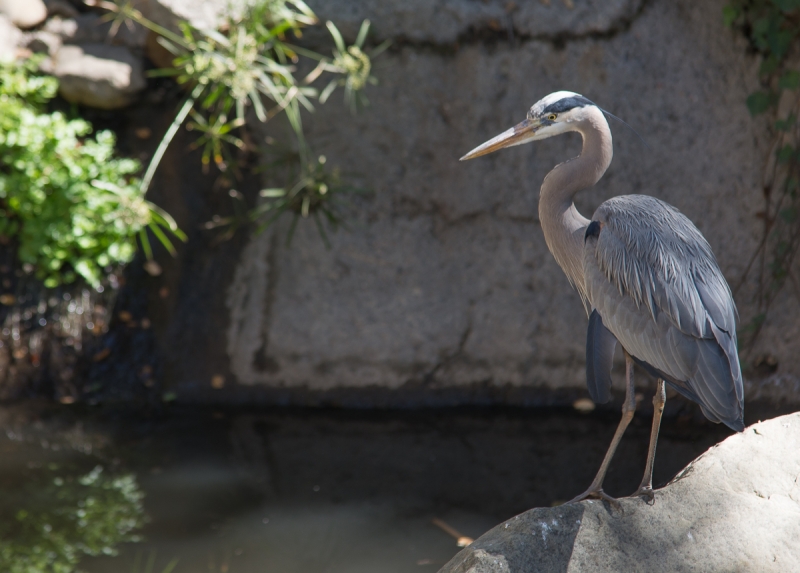
Great Blue Heron, Ardea herodias (~38.4–53.0 inches)
Family: Herons, Egrets, and Bitterns (Ardeidae)
Seasons Found: Common during all seasons
Conservation Status: Low Concern
Distinctive Features: long legs and neck; light grayish-blue and white; tan on the neck; harsh squawks
Great Blue Herons will eat almost anything within the striking distance of their sharp bills, such as fish, amphibians, reptiles, insects, other birds, and small mammals. This wide variety includes frogs, salamanders, turtles, snakes, insects, rodents, and many species of small waterbirds. Great Blue Herons use their dagger-like bills to impale larger fish and grab smaller prey in their strong mandibles. Similarly to Mallards, Great Blue Herons are susceptible to habitat disturbance and reduced water quality. Human disturbances such as traffic and motorboats can disturb nesting areas in wetlands, and chemical pollutants affect their feeding grounds.
Acknowledgments
Thank you to Rebecca Coulter and Jenna Rolle for editing, advising, and sharing their knowledge of birds and writing to make it possible to create this guide.

About the Author
Shio Chiba is a recent graduate of the Museum’s Quasars to Sea Stars multi-year work/study/intern program. As a quasar, she worked in the Nature Collection and the Development Division, and as an assistant aquarist at the Sea Center. Chiba has conducted independent research on Snowy Plover and American Crow population trends.
Sources & Further Reading
“Audubon Guide to North American Birds” National Audubon Society, accessed March 16, 2021, audubon.org/bird-guide.
“All About Birds,” Cornell Lab of Ornithology, accessed March 16, 2021, allaboutbirds.org.
Both the Audubon Guide to North American Birds and Cornell Lab of Ornithology’s Bird Guide provide general information about bird species including habitat, behavior, and diet. They also include maps, examples of songs and calls, identification information, and articles related to the species you search. The Audubon website also provides resources to get more involved with Audubon initiatives and events.
“County Bird List,” sbcobirding, accessed March 16, 2021, sbcobirding.com/countybirdlist.html.
The County Bird List organizes all the bird species recorded in Santa Barbara County by family. It includes scientific names along with common names, and is updated when additional species are recorded.






2 Comments
Post a CommentFabulous guide to our local birds! Thanks for sharing.
Excellent work, Shio!